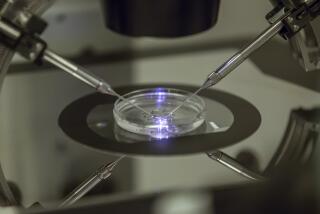Sometimes, predicting the future would be a good thing, as with IVF
- Share via
In vitro fertilization treatment can be emotionally grueling and prohibitively expensive, and some people decide they can’t — they absolutely can’t — go through it again. If only there was a way to accurately predict the chance that such treatments would lead to a real-life bundle of crying, needy, with-you-for-18-years-minimum joy.
Stanford University researchers say they’ve done it, at least for women who’ve already had one round of IVF.
In research published online Monday in Proceedings of the National Academy of Sciences, they explain their model for predicting the odds that a live birth will result from IVF treatment. They say using detailed information on a woman’s hormone levels, the quality of her eggs and the characteristics of each embryo goes far beyond the largely age-of-the-mother-based predictions currently used.
Here’s their IVF-prediction study plus the “in other words” news release, which points out (as do we) that the researchers are such believers in their model that they’ve created a company to sell tests to help in this decision-making process.
The researchers do seem confident. They conclude in the discussion of their findings: “Despite being influenced by multiple maternal, paternal, and embryo variables, and their potential interactions, we have established that live birth outcomes in IVF can be subjected to rigorous scientific investigation, and they can be predicted.”
No doubt about it, prediction would be a good thing. Here’s an article from WebMD about IVF. Note the detail about how much one cycle costs: $10,000 to $15,000.
And that’s just the quantifiable — unemotional — costs.






